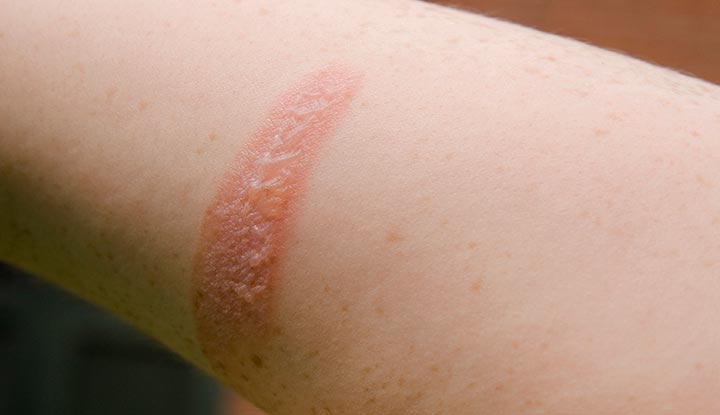Second-degree burns are a mild type of burn that causes blistering, shiny skin, pain and skin discoloration. They’re the most common type of burn. If your burn is small, you can treat this type of burn at home.
Advertisement
Cleveland Clinic is a non-profit academic medical center. Advertising on our site helps support our mission. We do not endorse non-Cleveland Clinic products or services. Policy

A second-degree burn is a mild to moderate burn, and it’s the most common type. A burn is tissue damage caused by a heat, chemical or light source. A second-degree burn damages the outer layer of your skin (epidermis) and the second layer of your skin (dermis). It’s less severe than a third-degree burn. You can treat most second-degree burns at home.
Advertisement
Cleveland Clinic is a non-profit academic medical center. Advertising on our site helps support our mission. We do not endorse non-Cleveland Clinic products or services. Policy
Features of a second-degree burn include:
There are three main degrees of burns. You can identify what type of burn you have by its appearance. A first-degree burn may only cause skin discoloration. A second-degree burn includes blisters, a darker tone and a shiny, moist appearance. A third-degree burn may cause your skin to turn black and dry out. You may have second-degree burn symptoms with third-degree symptoms in the same area. You can have symptoms of several types of burns in the same place.
The location of a second-degree burn varies based on the cause. Some common locations you could get a second-degree burn include your:
There are several ways that you can get a second-degree burn. Some of the most common causes of second-degree burns include:
During a second-degree burn, a heat, chemical or light source destroys and goes through the first and second layers of your skin. This causes damage to the cells in your skin. Cell damage triggers your immune system to activate to prevent further damage to your body. You may experience skin discoloration and swelling, which is a sign that your immune system is actively working to heal your injury. As your body repairs itself after a burn, dead skin cells leave your body as your skin peels and flakes at the site of your burn.
Advertisement
If you have a small second-degree burn (less than 3 inches in diameter), you can treat it at home:
A common prescription cream to treat second-degree burns is silver sulfadiazine (Silvadene®). If you have an infected burn, which is a burn that’s extremely painful, swollen and leaks pus, see a healthcare provider. They may prescribe antibiotics to clear the infection from your body.
You should keep your burn covered for the first few days after the event as you let your skin heal. Make sure your blisters stay closed on your skin. If a blister breaks open, you should keep your burn covered with a bandage to prevent an infection. If the blister isn’t broken, you can let your burn air out or breathe without a bandage.
Your second-degree burn will undergo three stages of healing:
The healing process can take several weeks after a second-degree burn.
Burns are preventable. You can prevent burns by:
Advertisement
Scarring is possible with second-degree burns. Not everyone will get a scar after a burn, and scars are more likely if you have a large, more serious burn. Your skin may appear lighter or darker than your natural skin tone after a burn. This is usually a long-term change to your skin tone that may fade over time.
On average, it can take one week to three weeks for your skin to heal after a second-degree burn. This timeframe can vary based on the size and location of your burn.
Visit a healthcare provider if your burn:
Children younger than 5 years old, people above 70 years old or people with a compromised immune system should have their burns treated by a healthcare provider.
An infected burn needs medical attention. Visit a healthcare provider if your second-degree burn has the following signs of infection:
Visit the emergency room if you develop a fever along with any of these symptoms.
The main difference between each type of burn is the depth of damage beneath your skin:
Advertisement
Each of these burns will look different on your skin. Visit a healthcare provider if you’re unsure what type of burn you have. You can have more than one type of burn at the same time.
Second-degree burns are the most common type of burn. You may have some discomfort on your skin as the burn heals, and scarring is possible. They’re preventable, but you can treat accidental burns at home if your burn is small. If your burn covers a large area of your skin or if you show signs of an infection, visit a healthcare provider.
Advertisement
Every day, people see your skin, hair and nails. At Cleveland Clinic, our expert and caring dermatology team will make sure they’re healthy and strong.

Last reviewed on 12/13/2022.
Learn more about the Health Library and our editorial process.